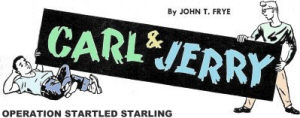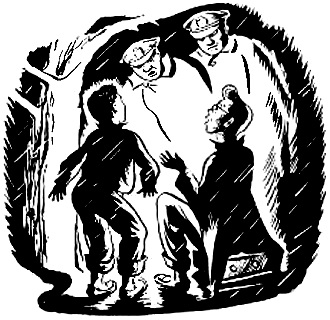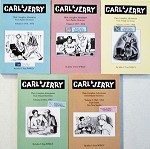Carl & Jerry: Operation Startled Starling
|
|||||||
Thanks once again to Mr. Ferrous Steinke, quite the Carl & Jerry fan, for providing the following content.
Jerry Bishop was in his basement laboratory busily trying to get the sound effect of a horse plodding through deep mud down on the tape of a new recorder he had received for Christmas. He was so engrossed in plopping a couple of his mother's cookie cutters up and down in a shallow dish filled with water near the recorder microphone that he scarcely looked up when the outside door was kicked open and Carl Anderson, his neighbor and best friend, strode in carrying a bird cage held gingerly out in front of him. "The next time you get a bright idea, Buster, you can do some of the legwork yourself," Carl growled as he set the cage down on the workbench. "Ah, you got one!" Jerry exclaimed as he shut off the recorder and strolled over to examine the black, medium sized bird with beady eyes and rather ruffled plumage inside the cage. "He doesn't look like he's hurt a bit. How did you ever catch him?" "It wasn't easy. Some men were shooting the starlings with shotguns around the courthouse, and that little buzzard had the ends of the feathers on one wing shot off. That didn't hurt him any, but it sure messed up his flying. At that, I had to chase him a couple of blocks before I caught him, and he managed to chew about thirty cents worth of hide off the back of my hand while I was stuffing him into the cage. Believe me, Old Scissorbill here is a crazy, mixed up starling; he thinks he's an eagle or some other kind of meat eating bird." "He does have a kind of nasty expression on his face," Jerry agreed as he looked at the bird glaring defiantly up at him. "This whole idea sounds strictly for the birds to me," Carl blurted out. "Tell it to me again. Maybe it will sound better if I hear it once more." "Last winter," Jerry patiently related, "a couple of zoologists at Penn State College captured a live starling and made a 52 tape recording of its cries of distress. Then the recorder was installed in a truck equipped with a public address system parked beneath some trees infested with an estimated 20,000 starlings. After the birds were settled for the night, the recording, tremendously amplified, was played through the public address speakers. The birds awakened to the distressed screams of one of their fellows, fled in terror, and never returned. We are going to try to work the same thing on the starlings roosting in the trees in the back yard. "Still sounds wacky," Carl commented; "but let's get on with it. You hold Scissorbill, and I'll work the recorder." "Now wait a minute," Jerry said hastily. "You'd better hold the bird and let me operate the recorder. After all, you two are already acquainted. On top of that, this is a pretty critical recording, and everything has to be just right. The tape must be run at the right speed; the gain control must be set just so; the—"
"To make the bird's cries sound natural, we must have good high frequency response. That means the tape will need to be run at its top speed of 71/2 inches per second." "How come higher tape speed improves the high frequency response?" "The recording head translates a sound wave of a given pitch into pulses of magnetic energy that 'prints' the magnetic coating of the moving tape with regularly spaced areas of magnetism. As the pitch or frequency of the sound goes up, these areas are spaced closer and closer to each other until finally, when the frequency of the sound wave is high enough, they start to merge together and so lose their separate identity that must be maintained if the sound is to be reproduced naturally. Now if we speed up the tape, this increases the separation of these magnetized areas; and we can then increase the frequency of the sound wave considerably before the areas start overlapping again." While Jerry was talking he had removed the tape reels from the recorder and started a short endless loop of tape running through the recording head. The microphone was placed on the edge of the bench, and Carl cautiously opened the door of the cage and reached inside for the bird. "Yow!" he suddenly yelled as the starling viciously shut down on his finger. "Shut up," Jerry callously commanded. "We want the starling's cry of distress, not yours. We don't want to scare people." Carl gave him a scorching look and then, angered, reached inside the cage and hauled the bird unceremoniously forth. Holding it upside down by its feet, he dangled it near the microphone while it screeched and screamed its protest at this treatment. "That's fine," Jerry said. "Now let's see what we've got." The recorder was switched to "Play," and instantly the basement was filled with a loud cacophony of raucous screaming that even seemed to take Old Scissorbill aback. At least he became quiet and listened attentively with his head cocked to one side. "That certainly ought to do it," Jerry said. "I don't know," Carl said dubiously. "That bird wasn't scared; he was mad. I'll bet a nickel that instead of calling, 'Help, help!' he was really saying something like, 'Let go of my leg, cuss you!' Can I wring his neck now?" "Sure, but you won't," Jerry said with a grin on his round face. "You don't fool me. I know how chickenhearted you are." "Chickenhearted, my eye," Carl said with a fierce scowl. "However, I think I'll just turn him loose and let a cat get him. That will be the kind of fate he deserves. Wringing his neck would be too easy a death." "Uh huh," Jerry said with a knowing smirk; "but now we've got to arrange a way of putting some real punch behind this recording. I thought we could use that twenty watt speech amplifier and modulator you use to modulate that command transmitter of your ham station. Let's see, that modulation transformer has a 5000 ohm output, doesn't it?" "Right." "And here's the speaker I intended to use," Jerry remarked as he dived into a corner of the basement and pulled forth a large speaker with a bell shaped trumpet. "I've been hanging on to this for a long time hoping to find a use for it. This job is rated at twenty five watts and has an eight ohm voice coil." "Not a very good match for 5000 ohms," Carl observed. "That's where this audio transformer will come in—I hope," Jerry said as he lifted a heavy transformer on to the bench, "Someone gave me the thing, but no instruction sheet came with it. The primary terminals are lettered, and the secondary terminals simply are numbered from 3. to 16. However, by looking up this model in a catalogue, I know the transformer is rated at twenty watts, that the primary is tapped for use across either 3000 or 5000 ohms, and that the secondary is designed to feed any voice coil impedance from one to thirty ohms. All we have to do is figure out which primary and secondary taps to use so that our eight ohm voice coil will be properly matched to the 5000 ohm output of the modulation transformer." "How are you going to do that?" "First, let's use the ohmmeter of our volt ohm milliammeter to measure the d.c. resistance appearing between the various primary taps. Across terminals P-P we measure 600 ohms, while there is only 500 ohms across In-P1. We may safely assume that the higher d.c. resistance indicates that the entire primary winding, designed for an a.c. impedance of 5000 ohms, is connected between the two terminals marked "P". "That's easy, but how about the secondary taps?" "Well, we know that the impedance ratio between the primary and secondary of a matching transformer is equal to the square of the turns ratio of these two windings, check?" "Check." "Our impedance ratio is equal to 5000/8 or 625/1. The square root of that is—" Jerry settled back on the couch with his battered slide rule, but Carl interrupted with, "Twenty five to one." "You're right, you mathematical genius!" Jerry exclaimed as he double checked with the rule. "We also know that if we put a certain a.c. voltage into one winding of a transformer and then measure the voltage appearing across the other winding, the ratio between the two voltages is equal to the turns ratio of the two windings. So-o-o-o, all we have to do is put twenty five volts into the primary winding and then measure the voltages appearing between the various taps of the secondary until we find a pair producing quite close to one volt. When these two taps are found, we can connect our eight ohm voice coil to them and be sure that when the whole primary is connected to the output of the modulation transformer, we shall have a complete match all the way around, which will insure a maximum transfer of power with a minimum of distortion." "Well, let's quit yakking and get with it," Carl, the man of action, said impatiently. "Okay. This war surplus equipment filament transformer puts out almost exactly twenty five volts of a.c.; so connect it to the primary of the transformer, and we'll start measuring the voltages across the secondary taps." In a matter of minutes the boys located a pair of secondary taps that indicates precisely one volt on the .c. scale of their volt ohmmeter. The ends of a heavy fifty foot extension cord were soldered to them, and the other ends of this cord were fastened to the speaker terminals. The primary of the matching transformer was connected to the secondary of the modulation transformer of Carl's amateur station speech equipment. A phone plug with a six ohm, one watt resistor fastened across its terminals was plugged in the "External Speaker" jack of the recorder, and a shielded lead went from the two ends of this resistor to the high level input jack of the speech amplifier. The six ohm resistor furnished a proper load for the secondary of the recorder's output transformer when the unit's six ohm speaker voice coil was automatically disconnected by plugging into the jack. By the time this rather weird lash up of equipment was completed, the boys had already received the third supper call; so they decided to suspend operations until after the evening meal. Right after supper, though, Carl was back over wearing a bright yellow slicker. "There's a pretty good drizzle going," he announced. "It takes a pretty mean guy to try and scare a poor little starling out of his nice warm tree on a night like this," Jerry said teasingly "Yeah!" Carl snarled as he rubbed his sore finger and made a threatening gesture at Old Scissorbill, still resting in his cage; "I can hardly wait." "Okay. You get outside the basement window, and I'll hand the speaker out to you. That way our cord will allow us to get right under the tree with the speaker. I want to be out there, too, when the fun starts; so I'm going to get everything down here going but the tape recorder. Then I'll turn it on and dash out there with you while the recorder amplifier is warming up." This plan was put into action. Jerry switched on the recorder, flipped the volume control well over to the "loud" side of its rotation, took a quick look to make sure the loop of tape was going smoothly past the playback head, and then dashed out the basement door, slamming it shut behind him. It was so dark in the back yard that he stumbled into Carl before he was able to make out the yellow coated figure of his friend standing there in the cold drizzle expectantly pointing the open mouth of the loudspeaker straight up into the tree branches overhead. For what seemed an interminably long time, nothing at all was heard from the speaker; but then a beginning murmur of sound quickly swelled into a screaming roar. Just as a photographic enlargement of some small, familiar object converts it into a grotesque, unrecognizable thing, so did the great amplification of the starling's screeching change the sound into a hoarse, brazen noise totally unlike anything either of the awestruck boys had ever heard before. The thought flitted through Jerry's mind that a dinosaur in his death throes must have made a sound like this. Porch lights flashed on up and down the street, and shafts of light streamed across back yards as rear doors were thrown open. "Shut it off! Quick!" Carl screamed directly into Jerry's ear. Released from his trance by this suggestion, Jerry turned and in a stumbling run clattered down the basement steps and threw his weight against the door. It did not budge. The night latch on the inside had locked itself. Hesitating only a minute, Jerry bounded back up the steps with a vigor most unusual to his leisure loving nature and ran around to the front of the house, through the front door, down the hall, down the basement steps, and into his laboratory. He made a flying leap across the room, and his clawing fingers switched off the tape recorder. Instantly the bellowing stopped, only to be followed by shouting and the sound of running feet going past the basement windows. Jerry turned off the basement light and stood there panting in the darkness for a few seconds until he could regain his breath; then he very quietly opened the outside basement door and tiptoed up the steps. The back yard was no longer in darkness. Carl was sitting squarely in the center of a blinding circle of light cast by the spotlight of a police squad car parked in the alley; and two policemen, who seemed unnecessarily large, were getting out of the car. Neighbors carrying flashlights were flitting around like fireflies. "All right, all right," one of the policemen said, "which one of you called in that 122-report about a dog being run over in this alley?" "Yeah," his fellow officer chimed in, "and which one reported there was a panther ten feet long slinking up and down and screaming its head off back here? Was it you?" he demanded of Carl. "No sir," Carl promptly replied. "I heard an awful noise, but I didn't see a panther or hear any dog." For a few minutes the policemen questioned the neighbors without getting any two of them to agree on what the noise sounded like. Then they flashed the spotlight all around, peered into a few garages and basement entrances, and finally decided the whole thing was a false alarm. "Probably some guy with a stuck automobile horn caused all this hullabaloo," one of them remarked as he got back into the squad car. "Sonny, you had better get into the house out of this drizzle," he advised Carl as they started to drive away. "Yes sir," Carl said meekly without moving. Jerry sidled out to Carl and asked out of the corner of his mouth, "Where the heck is the speaker?" "What do you think I'm sitting on?" Carl demanded in a hoarse whisper as he spread out the tail of his overcoat a little more. "I was scared to death they'd trip over the cord, but they never even saw it." In a few minutes the neighbors drifted away, and the boys got the speaker back inside the basement. "We'll not try that again," Jerry said emphatically; "and the heck of it is I was too excited to notice if we scared any starlings or not." "I wasn't," Carl answered. "While the cops were playing their spotlight and flashlights around, I kept looking up in the tree. The birds did take off at first, but they just made a little circle and came right back as soon as the noise stopped." "Those Penn State starlings must be a timid, cowardly crew totally unrelated to Old Scissorbill and his hardboiled chums," Jerry offered. "Nope," Carl demurred, "I still think that pint sized eagle crossed us up. During that hour or so while you were leisurely shutting off the recorder, I had to listen to that racket coming right up in my face, and I'll swear that what Old Scissorbill was yelling didn't sound like 'Take to the hills!' at all; instead, it sounded more like, 'Hey, Rube! Come and help me take 'em!' " ""Well," Jerry remarked as he prepared to turn out the lights, "I guess Electronic Experimenters, Ltd., will have to chalk this up as a howling failure—but it had its moments !" END
Posted |
|||||||

 By John T. Frye
By John T. Frye "Oh all right," Carl said resignedly. "I didn't
really expect to get away with it, but it was worth a try. What do you mean the
tape has to be run at the right speed?"
"Oh all right," Carl said resignedly. "I didn't
really expect to get away with it, but it was worth a try. What do you mean the
tape has to be run at the right speed?"  Carl & Jerry, by John T. Frye
Carl & Jerry, by John T. Frye